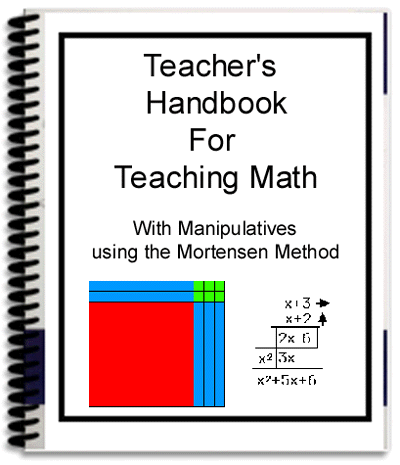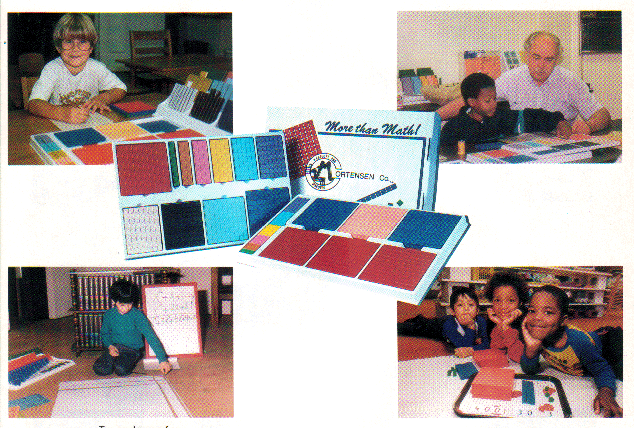
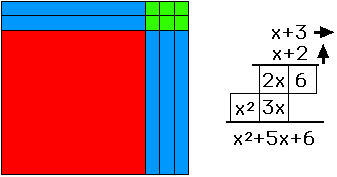
Jean Piaget & Psychological Principles
at work in
Teaching Math with Manipulatives
by Geoff White, B.Ed. (Southampton, UK)
Related Topics: A Philosophy of Teaching Math
A Brief Summary of the Principles of the Mortensen Method at work
1-3 'Seeing' the number develops Imagination
4. Construction helps in acquiring experiences by tactile-motor-kinaesthetic senses
5. Analysis develops analytical thinking & problem-solving skills
6. Drawing develops the powers of visualization
1-6 Combining all of the above steps provides the necessary experiences for the mind to "Generalize the experiences" which is the pre-cursor to Understanding - our goal.
7. Notation - develops attention to detail, associates spatial reality with symbols used in notation
8. Record the answer
NB. if you use only steps 7&8, all you are doing is developing memorization and anxiety by focusing too much on the answer.
Jean Piaget, the Swiss Psychologist,
identified two major aspects of cognitive development - the process of coming to know, and the stages of cognitive development we move through as we gradually acquire this ability.
The process of "coming to know" is the interaction of assimilation and accommodation.
With the passage of time and by having the necessary experiences the child
passes through four stages:
sensori-motor,
pre-operational,
concrete operational and
formal operational.
He observed that abstract thinking in Math, say, occurs at a later stage usually associated with the age of puberty or older. Many have concluded that topics like algebra and calculus therefore must be presented only in later grades, if at all, so that the student will have developed the necessary cognitive maturity to handle such difficult stuff. Mortensen demonstrates that you can present a topic in a concrete fashion, using manipulatives so that understanding can take place much sooner. Of course if you want to make it difficult you can present it in a purely abstract manner, but why would you?
"Many pre-school and primary programs are modeled on Piaget's theory, which, as stated previously, provides part of the foundation for constructivist learning.
Discovery learning and supporting the developing interests of the child are two primary instructional techniques. It is recommended that parents and teachers challenge the child's abilities, but NOT present material or information that is too far beyond the child's level. It is also recommended that teachers use a wide variety of concrete experiences to help the child learn (e.g., use of manipulatives, working in groups to get experience seeing from another's perspective, field trips, etc)." - from Cognitive Development, W. Huitt & J. Hummel, 2003
Stages of Cognitive Development.
Piaget identified four stages in cognitive development:
1. Sensorimotor stage (Infancy). In this period (which has 6 stages), intelligence is demonstrated through motor activity without the use of symbols. Knowledge of the world is limited (but developing) because its based on physical interactions / experiences. Children acquire object permanence at about 7 months of age (memory). Physical development (mobility) allows the child to begin developing new intellectual abilities. Some symbolic (language) abilities are developed at the end of this stage.
2. Pre-operational stage (Toddler and Early Childhood). In this period (which has two substages), intelligence is demonstrated through the use of symbols, language use matures, and memory and imagination are developed, but thinking is done in a nonlogical, nonreversable manner. Egocentric thinking predominates
3. Concrete operational stage (Elementary and early adolescence). In this stage (characterized by 7 types of conservation: number, length, liquid, mass, weight, area, volume), intelligence is demonstrated through logical and systematic manipulation of symbols related to concrete objects. Operational thinking develops (mental actions that are reversible). Egocentric thought diminishes.
4. Formal operational stage (Adolescence and adulthood). In this stage, intelligence is demonstrated
through the logical use of symbols related to abstract concepts. Early in the period there is a return
to egocentric thought. Only 35% of high school graduates in industrialized countries obtain
formal operations; many people do not think formally during adulthood.
Have you ever wondered if teaching math has to be like pulling teeth? When you hear the children groan when you ask them to get out their Math books, do you ever ask yourself if there is a better way? Wouldn't it be nice if the students wanted to learn more Math? How about if they wanted to stay in at recess to do math problems instead of going out to play?
|
|

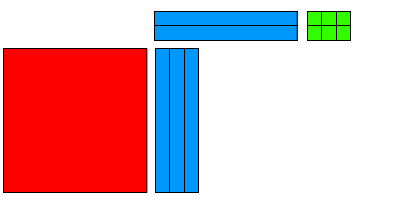
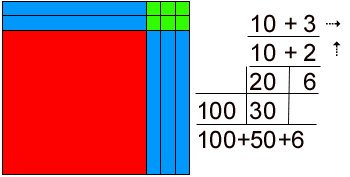
Jean Piaget demonstrated that children pass through four stages of cognitive development reaching the ability to reason abstractly only at about puberty. While rates of development vary somewhat from child to child it is generally understood that reasoning by use of abstract symbols is beyond most pre-teens. But what is math if not reasoning by using symbols? The Mortensen approach decodes the mathematical language of symbols into a spatial reality that children are most comfortable with dealing. By teaching Math concepts using Tactile-Motor-Kinaesthetic experience and by enhancing their ability to VISUALIZE, the Mortensen method enables students of all ages to engage with Mathematics in previously untried ways. The results are immediate and undeniable. Building it (the problem) with Manipulatives, Drawing it, to enhance the experience, and to develop the student's ability to Visualize are key elements in the Mortensen method. More than any other single thing, enhancing the student's ability to SEE the problem, distinguishes the Mortensen method from any other.
|
|
So what do you need to start teaching math the Mortensen way?
The Handbook for Teaching Math with Manipulatives is 250 large pages of detailed, illustrated, easy-to-read instruction in employing the Mortensen method written by Canada's leading practitioner of the method. In an 8.5 by 11 inch format, it lays flat on the table for easy reference - no more stiff-spined textbooks that need to be weighted down for hands-free use. Included are 200 pages of actual lessons on all topics from whole number operations to fractions to functions! Never be without a lesson again! Every lesson/example is fully illustrated. After all, this is a visual approach.
An idealized Teacher-Pupil dialogue is included in all lessons. If only the students would learn their part in the script! Key phrases in simple language are highlighted, giving the preferred verbalizations to transmit important math concepts. Actual student responses give experienced teachers the right track to run-on. A consistent approach gives clarity to the pattern employed with all examples in the curriculum. Every example includes the steps of Build it with manipulatives, Draw it to develop Visualization, do the Notation, and Record the answer. Specific lessons on teaching Notation, e.g. algorithms for operations, occur throughout. Also a chapter on the teaching of algorithms of notation and the significance of the relationship between them and the spatial reality of the constructions is included. The psychology of employing manipulatives is explained. In particular the value of the tactile motor-kinaesthetic experiences to learning mathematics is discussed. Order The Teacher's Handbook for Teaching Mathematics with Manipulatives right now, and I will include a 5-hour VHS videotape of my workshop covering the entire Mortensen method using three different sets of manipulatives, at no extra charge! This videotape of my workshop, videotaped at the University of Calgary, is a $99 value by itself. But I'll include it FREE if you order within 30 days. Imagine being able to reference lessons from the curriculum, including: all operations: problem solving, decimals, algebra, fractions - and being able to watch the lesson being taught by "Canada's resident expert on Mortensen Math" at the same time!
